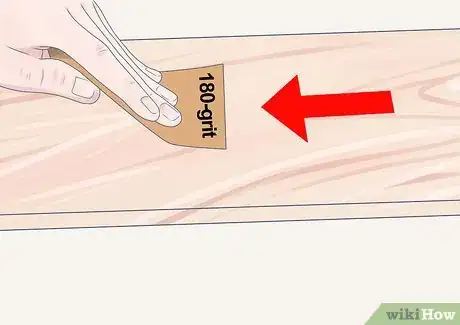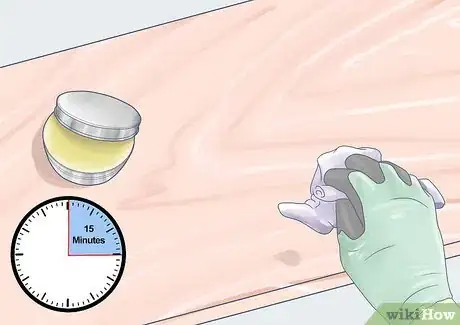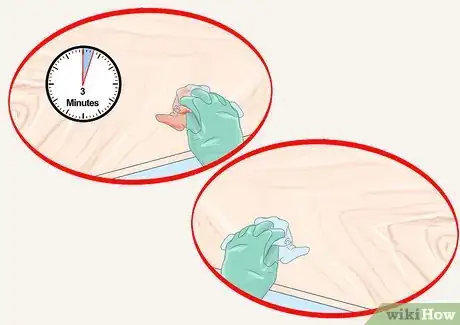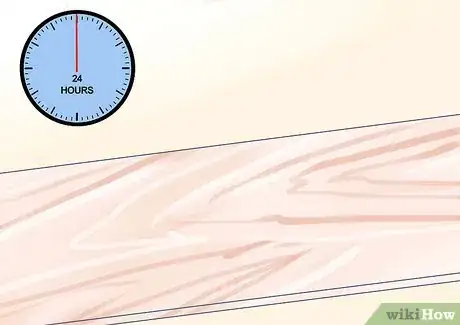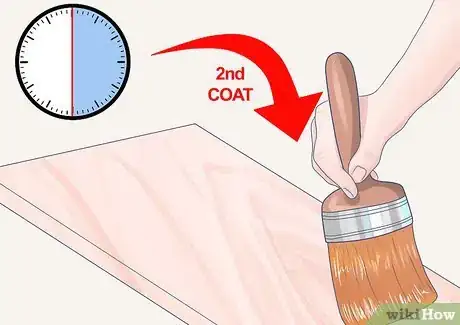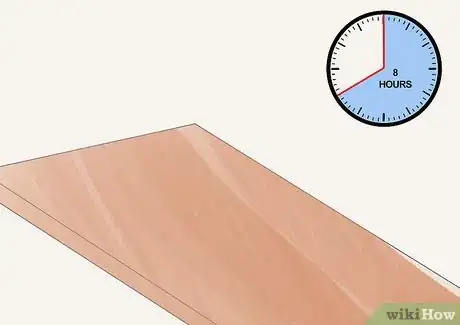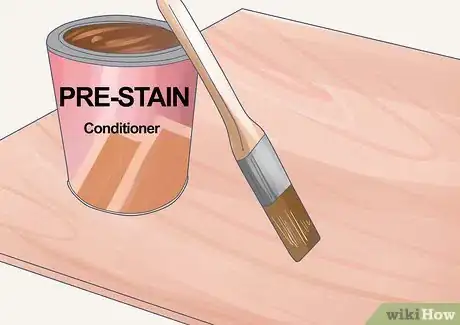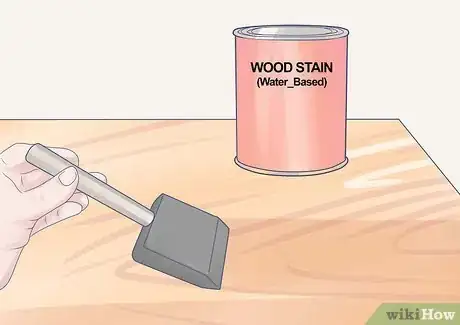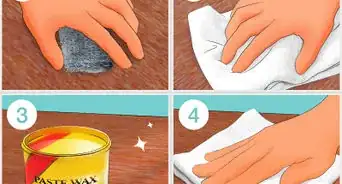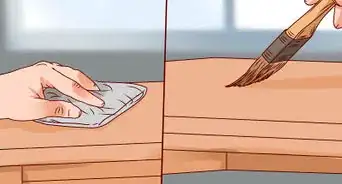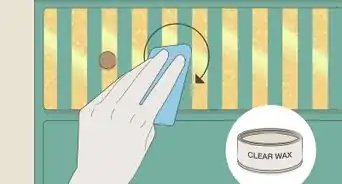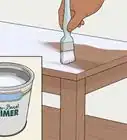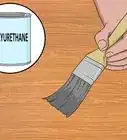wikiHow is a “wiki,” similar to Wikipedia, which means that many of our articles are co-written by multiple authors. To create this article, volunteer authors worked to edit and improve it over time.
wikiHow marks an article as reader-approved once it receives enough positive feedback. In this case, 90% of readers who voted found the article helpful, earning it our reader-approved status.
This article has been viewed 199,394 times.
Learn more...
Veneer is very thin sheets of hardwood sliced from logs for use mainly in the furniture industry. Veneer allows a craftsman to finish a woodworking project with a beautiful exotic wood that might not otherwise be affordable or attainable. Since veneer is real wood, it is stained in much the same manner as a solid piece of wood, but there are differences in technique between the 2 that should be noted.
Steps
-
1Choose your stain for the project. You have a choice of oil based, water based and gel stains. Each one has slightly different qualities that make it ideal for one wood but not another.
- An example of this is that some trees, such as teak and rosewood, have more natural oil in them than other woods such as oak or hickory. The oily wood will not take a water based stain as well as one of the less oily woods, so this has to be considered when choosing stains.
- The basic steps for staining veneer are the same but setting and waiting times are different for each of the stains, gel, oil and water.
-
2Check the veneer carefully to see that it is smooth. Most mill sawn veneer and backed veneer will not need sanding. Mill sawn veneer is very thin, 1/42 inch (0.60 mm) and will not stand up to heavy sanding.Advertisement
-
3Sand carefully if necessary, starting with a 180 grit sandpaper and being sure to follow the direction of the wood grain. Stop and check frequently to avoid damaging the veneer.[1]
-
4Clean veneer thoroughly.
-
5Stir stain vigorously before use and every 30 minutes while working. Test for correct color on a piece of scrap veneer or in an inconspicuous spot.
-
6Brush on a wood conditioning product if your veneer is a soft or porous wood such as pine. Allow the conditioner to stand for 5 to 15 minutes, and wipe off with a clean rag. Do not wait more than 2 hours before applying gel stain.
-
7Apply stain to veneer with a rag, soft bristle paint brush or a foam brush, following the wood grain. Allow it to set for 3 minutes and wipe off stain with a clean rag, again following the grain of the wood.[2]
-
8Allow to dry for 8 to 10 hours. If the color is not deep enough, apply additional coats in the same manner as the first until you have the desired look.
-
9Allow to set up for 24 hours before applying a sealer if desired.
Oil Stain Veneer
-
1Apply oil stain with a cloth or soft bristle brush, following the grain of the wood. Wait 5 to 15 minutes to allow stain to penetrate the veneer, and then wipe off excess stain with a clean cloth, again following the grain of the wood.[3]
-
2Apply second coat of stain, if needed, once the 1st coat has set up, usually 4 to 6 hours.
-
3Allow to dry for 8 hours before applying a sealer if desired.
Water Stain Veneer
-
1Apply a pre-stain conditioner and let it set up for 1 to 5 minutes. Conditioner is usually necessary when using a water based stain. Wipe off excess with a clean cloth.
-
2Apply water stain with a cloth, synthetic bristle brush, paint pad or foam brush, following the grain of the wood. Allow stain to penetrate for no more than 3 minutes before wiping off excess with clean cloth that is slightly dampened with the stain, again following the grain of the wood.[4]
-
3Apply second coat of stain, if needed, once the 1st coat has set up, usually 2 hours.[5]
-
4Wait at least 3 hours before applying a sealer coat if desired.
Community Q&A
-
QuestionIf I want to stain something darker, do I go through the same steps as the bare veneer?
 Community AnswerNope, just add the stain to darken it up. You'd only start from scratch if you wanted to go lighter, which you don't because it's veneer.
Community AnswerNope, just add the stain to darken it up. You'd only start from scratch if you wanted to go lighter, which you don't because it's veneer. -
QuestionI want to use veneer tape on the edge. Do I put it on before or after I stain my shelf?
 Community AnswerYou put the edge banding on before you stain, then you stain the shelf and the edge at the same time. This makes for a more uniform color.
Community AnswerYou put the edge banding on before you stain, then you stain the shelf and the edge at the same time. This makes for a more uniform color. -
QuestionHow do I remove old wax from a walnut veneer table?
 Community AnswerYou can use a torch or heat gun, but that might release the veneer glue. Any stripper from Home Depot or Lowes would work, but make sure you rub the surface with ScotchBrite and lacquer thinner. Then, scrub the surface with a new ScotchBrite and Naptha. If the Naptha doesn't flash off (evaporate) immediately, you must repeat above steps.
Community AnswerYou can use a torch or heat gun, but that might release the veneer glue. Any stripper from Home Depot or Lowes would work, but make sure you rub the surface with ScotchBrite and lacquer thinner. Then, scrub the surface with a new ScotchBrite and Naptha. If the Naptha doesn't flash off (evaporate) immediately, you must repeat above steps.
Things You'll Need
- Paint brush
- Foam brush
- Paint pad
- Sandpaper
- Stain
- Wood conditioner
- Clean cloths
- Wood sealer
References
- ↑ https://www.oakwoodveneer.com/things-to-remember-when-sanding-veneer.html
- ↑ https://www.youtube.com/watch?v=RRRLc1Q9pmM
- ↑ https://www.bobvila.com/articles/2150-paints-and-finishes/
- ↑ https://living.thebump.com/apply-waterbased-stain-5963.html
- ↑ https://living.thebump.com/apply-waterbased-stain-5963.html
- http://www.joewoodworker.com/veneering/why-use-veneer.htm


